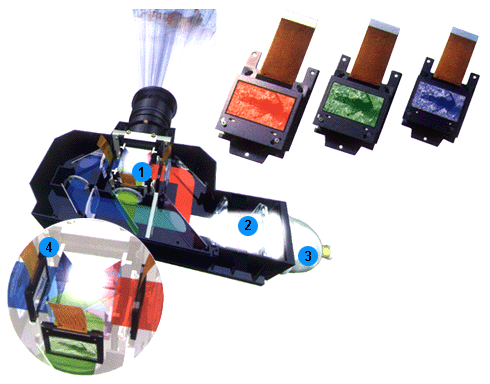 |
What's in the picture on the left?
|
 |
What's in the picture on the left?
|
I'd prefer a LCD projection TV over the ones with CRT tubes because it's light and can be moved easily, it does not have convergence problems and the picture itself does not pump. A pumping picture is very annoying, because this pumping effect is visible every time a bright after a dark picture is displayed.
A good possibility to check for convergence problems is to display some teletext pages and watch closely for color bleeding surrounding the teletext characters. You may have to check the teletext text display using several different TV channels, because sometimes text is displayed on a black background and sometimes the text background is white.
The table below contains some LCD projection TV (Year 2000 production models, picture aspect ratios are misleading, because these pictures do come from different sources and I did resize them a little to fit in more easily into the table cells). These models are available in Europe and do come with one or two (the Sony ones) PAL TV tuners. Of course they can be used together with NTSC equipment.
What about plasma screens?
These screens do get bigger and bigger and prices are coming down, too. But the technology has some serious flaws: Plasma screens tend to burn in, they get worse over time (less bright), they consume a lot of energy (350w/h and even more) and they often com with an external and sometimes even optional tv tuner box. Some of them do have noisy fans to cool the cabinet. This can become very annoying, too.
Large widescreen LCD TVs - the next hot thing around the corner!
The best alternative to plasma and rear projection tv sets will be an LCD tv set. Bright colors, no color bleeding nor burn in problems, moderate power consumption: This is the future of the ordinary tv set as we know it. If sizes go up to 1.2m or even more in diameter, it will really become interesting owning such a display. Samsung has one of these displays ready to the market. It's called LW40A13W in Europe and the diameter size of the screen is 1m! The price is hot, too. Some info about this technology can be found here.
Toshiba 40 PL 93 G
102 cm / 16:9 (case color daylight-silver)
Single Panel LCD
Toshiba 44 PL 93 G
112 cm / 4:3 (case color daylight-silver, black contrast filter)
Single Panel LCD
Sony KL-37W2/2
94 cm / 16:9 (also available in case color dark gray (KL-37W2)
3-Panel LCD
Sony KL-50W2/2
127 cm / 16:9, also available in case color dark gray (KL-50W2)
3-Panel LCD
Toshiba Corporation Europe (UK Website) or via this direct link: Toshiba Germany (Large TV set site)